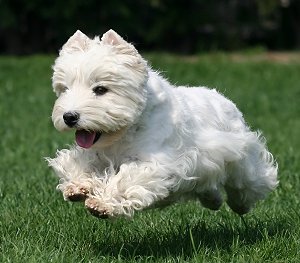Teach Your Pup to Come When Called
By Michele Welton, Dog Trainer, Breed Selection Consultant, Author of 15 Dog Books

This West Highland White Terrier is responding to her owner's Come command. Come is a critical command that every responsible owner must teach and that every respectful companion dog must master.
Along with "Good" and "No", which tell your puppy which behaviors you want and which behaviors you don't want, the most important word in his vocabulary is "Come."
Unlike fun tricks such as "Shake hands" or "Play dead", where it doesn't really matter whether a pup learns it or not....
"Come" is a mandatory word that must be mastered.
For the rest of your dog's life, he should never hear the word "Come" without being required to obey it. Dogs who fail to come when called have been allowed to learn that pattern. In the beginning, you need a leash to guarantee that your dog comes every single time he hears the word.
Step #1 in teaching "Come"
- Put a handful of treats in your pocket, and with your dog on leash, wander around your house or yard. When his attention is elsewhere (for example, when he is sniffing something), stop walking and say his name: "Jake!"
This sounds familiar, doesn't it? You did this when you were teaching your pup his name.
- When he turns to look at you in response to his name, call in a happy voice, "Come!" Trot backward a few steps, crouch down, and pat your hands together or pat your hands on your thighs.
- The instant he starts toward you, praise and encourage him, "Yes! Come!" Make sure the leash hangs completely loose as he comes toward you – don't reel him in like a fish!
- As he approaches you, don't reach out to grab him. Keep encouraging him with your hands and voice to come all the way to you. Praise, pet, and treat. Then "Okay!" which means he doesn't need to stay near you any longer.
 Sounds good! But what if...?
Sounds good! But what if...?
- What if he doesn't come toward you when you say "Come"?
- Or what if he comes partway, but stops?
- Or what if he comes toward you, but runs past?
Ah, that's why you attached the leash!
Use the leash to guide him to you, praising the whole way: "Yes! Come!" When he arrives, praise, pet, and treat.
- You want him to always succeed at doing the action that fits the word.
- And you want him to learn that coming to you is always associated with goodness.
Practice indoors. Practice outdoors in your yard. Keep the leash on so he MUST come. Give him dozens of experiences hearing the word "Come!" and coming toward you.
Step #2 in teaching "Come"
Switch to a long (15- to 30-foot) line. Wander around the yard with him, calling him when he's at the end of the line. After a while, drop your end of the line and let him drag it around. If you call him and he doesn't come, you can easily step on the line.
When he's so reliable that you would place a bet on him coming whenever you call, switch back to his regular leash and drop your end. Now if he doesn't come, you'll have a harder time getting hold of that short leash. So don't try this step too soon!
Suppose you DO drop the leash too soon and you call him and he doesn't come. Try one more call, in a firmer tone of voice.
If he still doesn't come, don't say another word. GO GET HIM.
 As you walk toward your disobedient pup, he may move away from you, even run away from you.
As you walk toward your disobedient pup, he may move away from you, even run away from you.
Don't run after him. Don't say anything. Just track him down silently. Walk firmly and purposefully. Keep your eyes fixed on him. Baffled and unnerved by your persistent, methodical following, your pup will most likely shrink down and give up. Or you will get close enough to step on the end of the leash.
So whether he just stands there waiting for you or you have to track him down, the goal is to get hold of his leash.
Once you have the leash in your hand, give it a good pop to propel him in your direction. Then start trotting backward, saying, "Come! Come!" Your voice should be quite firm here, not cheerful. After all this time, he knows what Come means. He chose to ignore it and you need to hold him accountable for his choices.
After backing up a bit and using the leash to make sure he is coming toward you the whole time, it's time to stop and change your attitude dramatically. Smile! Praise! Pet! Scoop him up, if he's small! Do whatever it takes to get his tail wagging!
The message you want to send is this:
"Whenever I call and you come to me, I am the ultimate happy place, full of praise and petting and perhaps a treat! Come to me and it's always good. If you don't come, I will track you down to the ends of the earth and make sure you come. Now, wouldn't you rather do it the easy way?"
This is a critical lesson for your pup to learn: that one way or the other, he has to do what you say, and that doing it on his own is more comfortable and rewarding than being made to do it.
My best-selling books – now available FREE on my website
 Respect Training For Puppies: 30 seconds to a calm, polite, well-behaved puppy is for puppies 2 to 18 months old. Your puppy will learn the 21 skills that all family dogs need to know. Click here to read for free.
Respect Training For Puppies: 30 seconds to a calm, polite, well-behaved puppy is for puppies 2 to 18 months old. Your puppy will learn the 21 skills that all family dogs need to know. Click here to read for free. Teach Your Dog 100 English Words is a unique Vocabulary and Respect Training Program that will teach your adult dog to listen to you and do what you say. Click here to read for free.
Teach Your Dog 100 English Words is a unique Vocabulary and Respect Training Program that will teach your adult dog to listen to you and do what you say. Click here to read for free. 11 Things You Must Do Right To Keep Your Dog Healthy and Happy helps your dog live a longer, healthier life. Get my honest advice about all 11 Things before you bring home your new puppy, because some mistakes with early health care cannot be undone. Click here to read for free.
11 Things You Must Do Right To Keep Your Dog Healthy and Happy helps your dog live a longer, healthier life. Get my honest advice about all 11 Things before you bring home your new puppy, because some mistakes with early health care cannot be undone. Click here to read for free.
